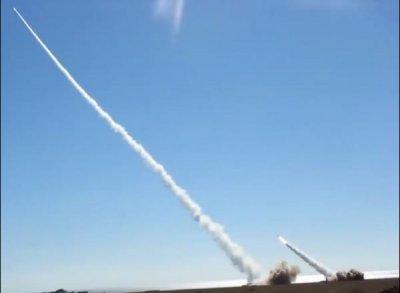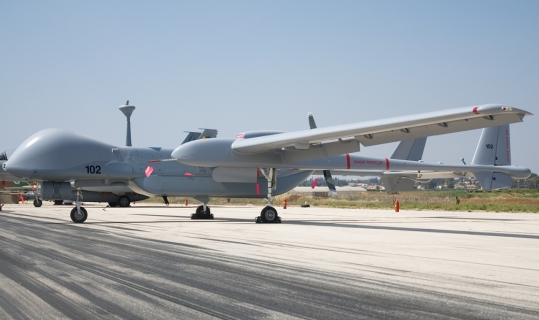October 18, 2016
The official investigation considered four scenarios that could explain the crash of flight MH17: an accident, a bomb, a fighter jet, and a surface-to-air missile. It excluded the first three and chose the fourth:
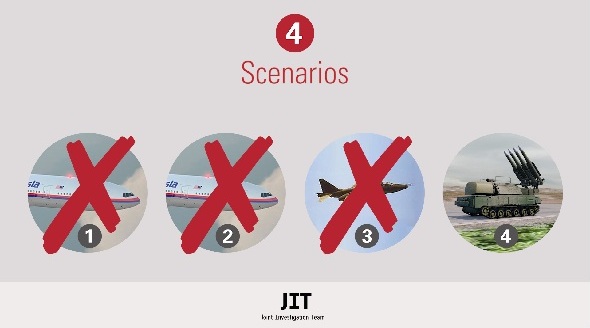
However, none of these scenarios is convincing:
- An accident or technical defect can be excluded due to the damage on the plane (holes in the fuselage)
- A bomb inside the plane can also be excluded due to the damage on the plane (punctures from the outside)
- A Ukranian fighter jet could not have reached the cruising altitude of a Boeing 777 (10 km), and wasn’t seen on any radar either.
- A surface-to-air missile (such as a BUK) would have made a loud noise and would have left a trail of smoke behind (launch smoke), visible for minutes and from several miles away. None of this was observed (or even documented) by any witness in the region.
Strangely, though, the official investigation did not consider
the fifth and most plausible scenario:
MH17 may have been downed by an armed drone.
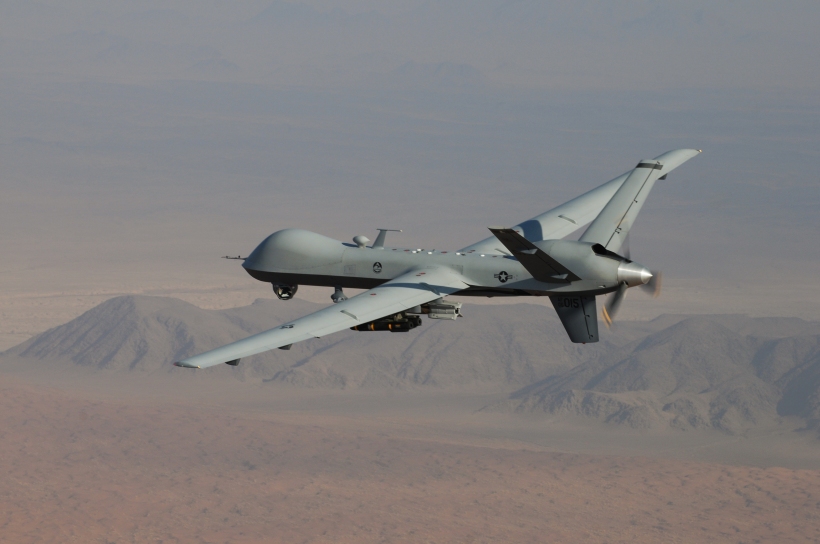
Indeed, all the evidence points towards
a modern combat drone having downed MH17:
- Unlike a Ukrainian SU-25 fighter aircraft, a modern combat drone (such as an MQ-9 Reaper drone) can easily reach an altitude of 10 to 15 km: the cruising altitude of a Boeing 777.
- And unlike a surface-to-air missile, a combat drone makes no noise and leaves no trail of smoke behind.
- But like a fighter jet, a modern combat drone can be armed with air-to-air missiles. Such air-to-air missiles can be infrared-guided short-range missiles (unlikely: warhead too small and targeting engines, not cockpit), but also radar-guided medium-range (beyond-visual-range) missiles, making it possible to reach air targets at a distance of up to 100 km. Indeed, General Atomics confirmed that the wings and maximum payload (1700 kg) of an MQ-9 Reaper drone are more than sufficient to mount even large air-to-air missiles. The largest air-to-air missiles (such as an R-33, R-37 or R-40) have warheads of up to 70 kg, just like a BUK.
- While a combat drone is much slower than a Boeing 777 (500 km/h vs. 900 km/h), an air-to-air missile is of course much faster than any airplane. Indeed, the missile is so fast (and small) that it will not be displayed on any civilian radar screen. It will be filtered out, as the official investigation confirmed:
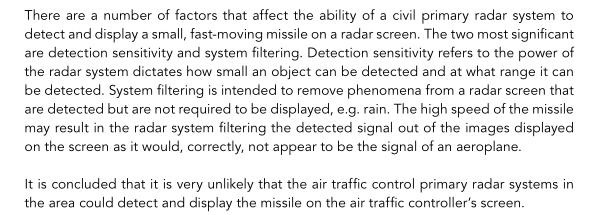
Missile not visible on radar screen. Excerpt from the Dutch Safety Board (DSB) report (page 114). The missile may have been visible in (raw) primary radar data. However, the official investigation only had access to secondary radar data (aircraft tansponder signals) and radar screen data, but not to primary radar data. Notably, Ukraine did not even provide a screen video of its primary radar data:
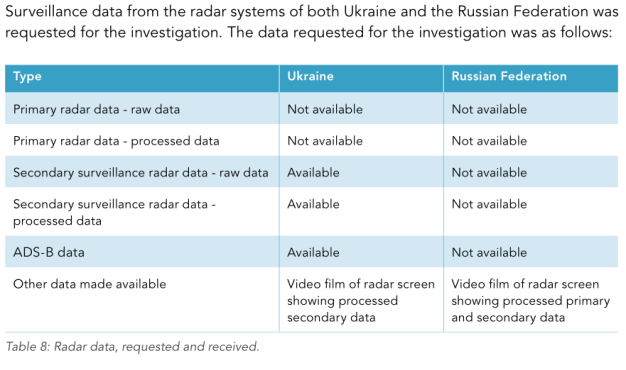
Primary radar data not available to investigation. Excerpt from DSB report (page 38). - Since no primary radar data had been provided, even the drone itself (without transponder) would be undetectable for the official investigation. Moreover, the drone may not have been registered at all by a local civilian radar if it was flying far away from the airplane, at a higher altitude (up to 15km), in military (non-civilian) airspace, or if it was covered by stealth coating.
- Furthermore, the damage caused by an air-to-air missile may be indistinguishable from a surface-to-air missile. In fact, many air-to-air missiles are also used as surface-to-air missiles (and vice versa). Examples include the American AIM-120 AMRAAM (medium-range) and the Israeli Python (short-range) and Derby (medium-range) missiles, which are used as part of the SPYDER air defence system.

An American AIM-120 AMRAAM medium-range radar-guided air-to-air missile. 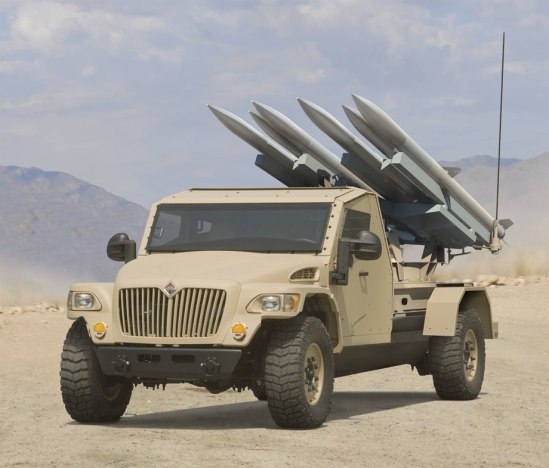
A surface-launched AMRAAM (SL-AMRAAM) - In August 2015, a Russian study suggested that MH17 was shot down by an Israeli Python-5 air-to-air missile (which usually targets the cockpit of a plane due to an advanced electro-optical guidance system). Yet the authors still assumed the missile must have been fired by a fighter jet. Because Ukraine has no fighter jets that can carry a Python-5, the authors speculated that a special version of a Georgian fighter jet may have been used. This seems unlikely.
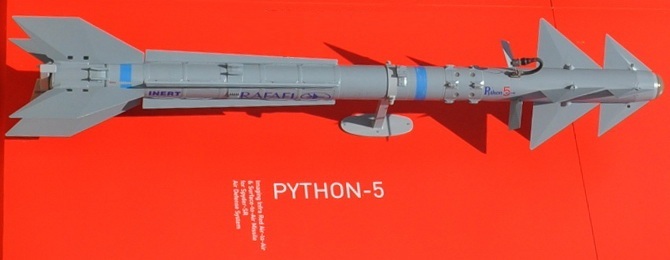
An Israeli Python-5 air-to-air missile. However, a Python-5 (or Derby) missile can also be carried by an Israeli combat drone such as the Heron-TP (Eitan), which easily reaches an altitude of 10 to 15km. (More on Israeli combat drones, see here, here and here).
Why did the official investigation not even consider the scenario of a combat drone?
Because they wrongly assumed MH17 could only have been downed by the local war parties, i.e. the Ukrainian military or the Eastern Ukrainian rebels. Therefore, they wrongly restricted the “air-to-air scenario” to a Ukranian fighter jet, which was then excluded. The official investigation did not consider the possibility that a third party with more advanced technological capabilities may have been involved in the downing of MH17.
Excerpt from the JIT presentation (after they have excluded an accident and a bomb):
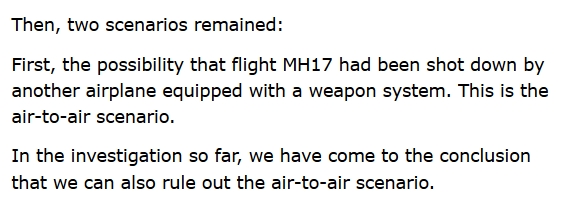
Why did the official investigation conclude it must have been a BUK missile?
The only reason why the official investigation concluded MH17 was shot down by a BUK missile is that two pieces of butterfly-shaped warhead fragments were “found” in the debris of the plane:

These butterfly-shaped warhead fragments are found in only one specific warhead: a BUK warhead of type 9N314M1:
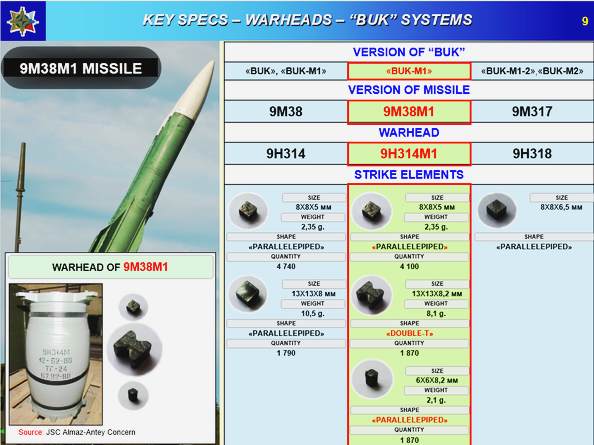
There is only one problem with this story: Almaz-Antey, the manufacturer of the BUK sytem, attested that a 9N314M1 warhead can only be used on an advanced BUK missile of type 9M38M1 (see image above). However, even the official investigation acknowledges that the Eastern Ukrainian rebels could not have possessed this advanced type of BUK missile, but only a standard missile of type 9M38. Yet according to the manufacturer, a standard 9M38 BUK missile can carry only a standard warhead of type 9N314, which does not contain the butterfly-shaped warhead fragments (see image above).
This was in conflict with the scenario favored by the official investigation. Therefore the investigators turned to the “Kiev Research Institute of Forensic Expertise”, which belongs to the Ukrainian Ministry of Justice. This institute contradicted Almaz-Antey and claimed that even a 9N314M1 warhead can be configured such that it is compatible with a standard 9M38 BUK missile. Proof: none. (And even if it were possible: why would the rebels acquire an advanced warhead simply to reconfigure it and put it on an old missile, when many standard warheads are still available?) Nevertheless, the official investigation ignored the statement made by the manufacturer of the BUK system and adopted the claim by the Ukrainian institute, as shown in the excerpt below.

There is however a much more plausible explanation for the two butterfly-shaped fragments found in the debris: they may simply have been planted prior to the examination in order to incriminate the rebels (and Russia), while overlooking the fact that the only warhead containing these fragments is perhaps not even compatible with a standard BUK missile.
This explanation is in line with several other facts:
- No butterfly-shaped holes were found on the cockpit or fuselage of MH17
- The corpses of the cockpit crew, in which one of the butterfly-shaped fragments was “found”, got a “special treatment” at a Ukranian mortuary prior to their delivery to the Netherlands
- The tests carried out by the manufacturer of the BUK system showed that if indeed a 9N314M1 warhead had been used, not only would there be many butterfly-shaped holes in the fuselage, but many more than just two such fragments would have been found in the wreckage. These results were again ignored by the official investigation.
- There is already strong indication that a third fragment was indeed planted in the wreckage after the crash.
More faulty logic
The next excerpt from the DSB report shows again the faulty logic applied by the official investigation:
- They first assume that “air-to-air” can only mean a local (Ukranian) fighter jet. Wrong!
- Because of this, they consider only locally available (Soviet/Russian) air-to-air missiles. Wrong!
- They identify three (Soviet) missiles with a fragmentation-explosion warhead (R-33, R-37 and R-40). However, because none of these contain “bow-tie” (butterfly) shaped fragments, they exclude the use of any air-to-air missile. Wrong!
- Because of this, they think they can exclude the air-to-air scenario altogether. Wrong!
- Finally, they add that in the case of an air-to-air attack, “another aircraft” (near MH17) would have to have been recorded “at least by primary radar data”. Wrong again! Besides, the investigation didn’t even have access to primary radar data (see point 5 above).
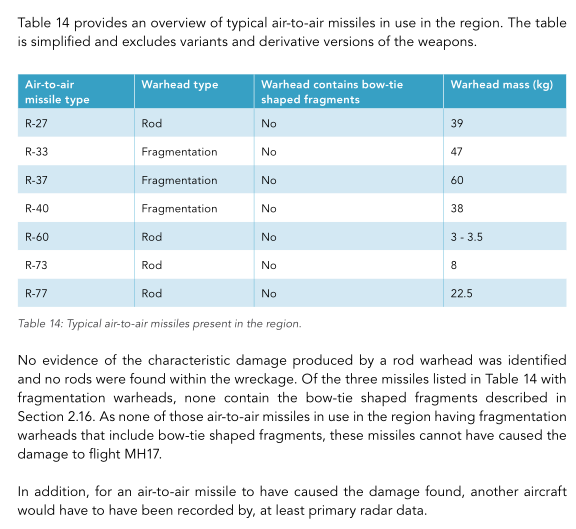
What about the simulation studies?
The official investigation did run several simulation studies to evaluate the size of the missile and its launch position. However, these simulations were run only after the air-to-air scenario was (wrongly) excluded. Therefore, the simulations only considered a surface-to-air missile. In other words, the simulations did not exclude an air-to-air missile at all. Moreover, as seen above, many air-to-air missiles are identical to surface-to-air missiles.
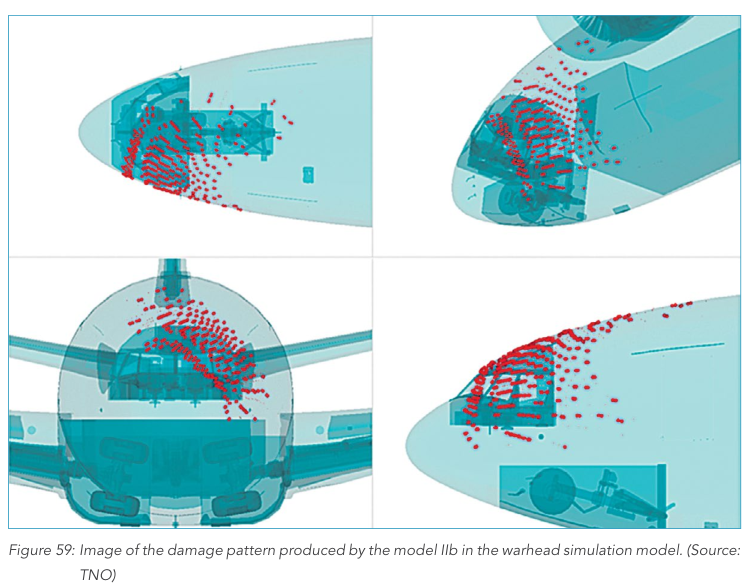
What about the video and photo evidence of a BUK missile being moved from Russia to Eastern Ukraine?
The videos and photos which purport to show a BUK system being moved from Russia to Eastern Ukraine (and back) mysteriously surfaced shortly after the crash of MH17. Moreover, they are of poor quality: low resolution, blurry, and no spinning wheels visible. There are two possible explanations to account for these photos and videos:
- They are fake, i.e. digital manipulations. See here.
- They are real, but have been taken at an earlier date. See here and here.
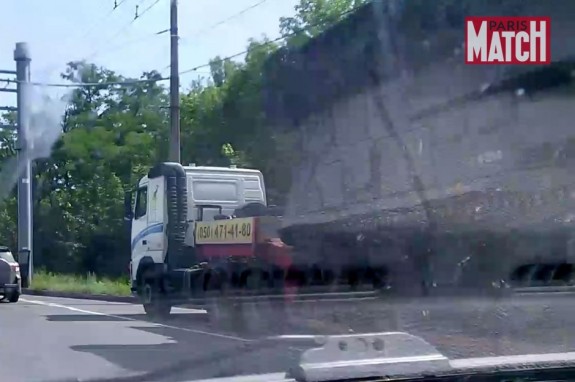
If the downing of MH17 was indeed a carefully planned operation, the preparation of such false photos and videos putting the blame to the rebels (and Russia) would have been an integral and rather easy part of it.
Who controlled the airspace in which MH17 was downed?
It is perhaps noteworthy that MH17 was downed in the airspace of Ukrainian Oblast (region) Dnipropetrovsk. In July 2014, this Oblast was controlled by Ukrainian-Israeli oligarch Igor Kolomoyskyi, who had been governor of Dnipropetrovsk since March of that year. Now:
- Kolomoyskyi is the second or third richest man of Ukraine
- He is a long-time arch-enemy of Russian president Putin.
- Russia issued an arrest warrant against him just two weeks prior to the crash of MH17.
- Kolomoisky also created a private army (Battalion Dnipro) which fought against the Eastern Ukrainian rebels.
- There is a video of a skype conversation with one of his officers (who suspected Kolomoyskyi had a hand in the downing of MH17) in which Kolomoyskyi called the crash of MH17 “a trifle”.
- Kolomoyskyi was also suspected to be the “mastermind” behind the Odessa massacre.
- In addition, Kolomoyskyi is the owner of Burisma Holdings, Ukraine’s biggest private gas company, which in May 2014 made Hunter Biden, the son of US vice president Joe Biden, one of its directors.
Perhaps all of this is not important. Or perhaps it is. At any rate, the official investigation never looked into it.
Why did nobody – not even Russia – ever mention the drone scenario?
If MH17 was indeed shot down by an armed drone, it is not guaranteed that Russia can prove this in any way. Without a clear proof, what should they say? Moreover, in the case of a combat drone, they cannot simply accuse the government in Kiev, but they would have to accuse far more powerful actors. Perhaps it is easier to just trade some meaningless allegations between the Ukranian military and the Eastern Ukranian rebels.
Recall that after the attack on a UN aid convoy in Syria in September 2016, the U.S. also immediately blamed Russia (without any proof, of course). Russia denied, but again it didn’t – and probably couldn’t – present any proof for another scenario.
Final note
Even if there were arguments speaking against an armed drone, the fact remains that the official investigation (both DSB and JIT) did not even consider this option. Thus no matter what, the official investigation used a faulty approach and prematurely ruled out the air-to-air scenario.
Updates and Reader Comments
- A reader remarks that on the very day MH17 crashed (July 17, 2014), a ten day long NATO military exercise in the Black Sea ended (BREEZE 2014). In other words, the military of the United States and nine more NATO members were present and active in the Black Sea region right up to the day of the MH17 disaster. According to a press release, these war games even involved “commercial traffic monitoring”.
According to another report, the exercise also included “the use of electronic warfare and electronic intelligence aircraft such as the Boeing EA-18G Growler and the Boeing E3 Sentry Airborne Warning and Control System (AWACS)”. Moreover, “BREEZE included the AEGIS-class guided missile cruiser USS Vela Gulf. AEGIS cruisers’ AN/SPY 1 radar has the ability to track all aircraft over a large region. (…) From the Black Sea, the Vela Gulf was able to track Malaysian Airlines 17 over the Black Sea and any missiles fired at the plane. U.S. AWACS electronic intelligence (ELINT) aircraft were also flying over the Black Sea region at the time of the MH-17 flyover of Ukraine. Growler aircraft have the capability to jam radar systems in all surface-to-air threats.”
The same report notes that “200 U.S. Army personnel normally assigned to bases in Germany were in Ukraine during the time of the MH-17 fly-over. They were participating in NATO exercise RAPID TRIDENT II. Ukraine’s Ministry of Defense led the exercise.”
- A reader notes that another option might be a so-called “suicide drone”, i.e. a loitering strike drone that includes a warhead in its fuselage and self-destructs into its target. These are basically missiles that fly like a plane. Due to their small size, they are invisible to radar detection systems. Examples include e.g. the Israeli IAI Harop and Hero-30. Usually, such drones attack ground targets and therefore operate at a low altitude (and rather low speed, about 200 km/h). If a high-altitude suicide drone exists at all, it would also require a fragmentation-explosion warhead to cause the damage observed on the wreckage of MH17. Moreover, due to its low speed, timing would be more difficult compared to a drone-fired air-to-air missile.
- If a radar-guided medium-range air-to-air missile was used, there are two options to provide the radar signal: active radar homing with an integrated radar transceiver, or semi-active radar homing with an external, ground- or air-based radar signal. Thus the drone itself doesn’t have to be equipped with a radar unit. In fact, this is another clear advantage over the BUK scenario: since the rebels didn’t have their own radar unit (even the “videos” only show a launching unit), they would have fired the missile “blindly”. This is unlikely to begin with, but it is even more unlikely that they would actually have hit a plane at 10 km altitude without radar guidance.
- A reader asks: “Can a BUK be fired from a drone at 10 km altitude, like other missiles that can be fired both surface-to-air and air-to-air (AMRAAM, Derby)? This might be an alternative explanation for BUK parts “found” in the wreckage.” Officially no airborne version of the BUK exists. (There is a navy version, though.) So this would have to be experimental. However, air-to-air missiles such as the R-33, R-37 or R-40 have a fragmentation-explosion warhead of comparable size to the BUK.
- If indeed an armed drone was used, the crash of MH17 most likely was a carefully planned false-flag operation. We then may ask “cui bono”, to whose benefit? Clearly the main beneficiary of this disaster was not Ukraine (in fact they haven’t gained anything: there is still a frozen conflict in the East), but rather geopolitical players using this conflict to further their own agenda. Moreover, the orchestrated reaction of the whole Western media (“Putin’s missile!” from day one) indicates that far more powerful actors may have been pulling this of.
